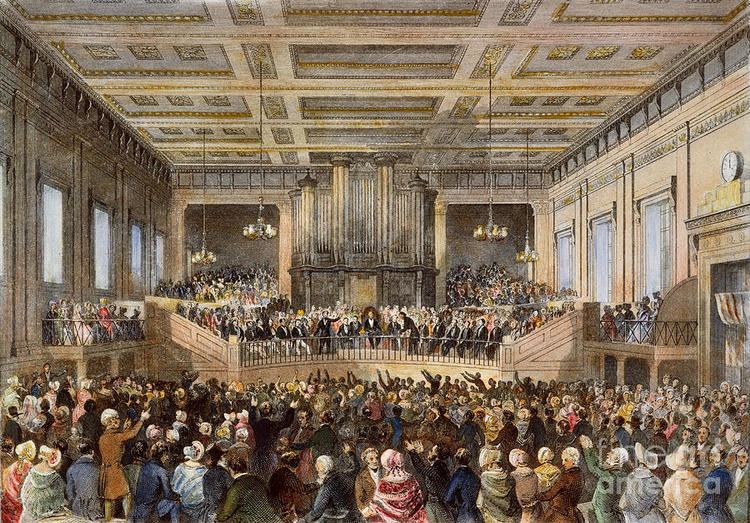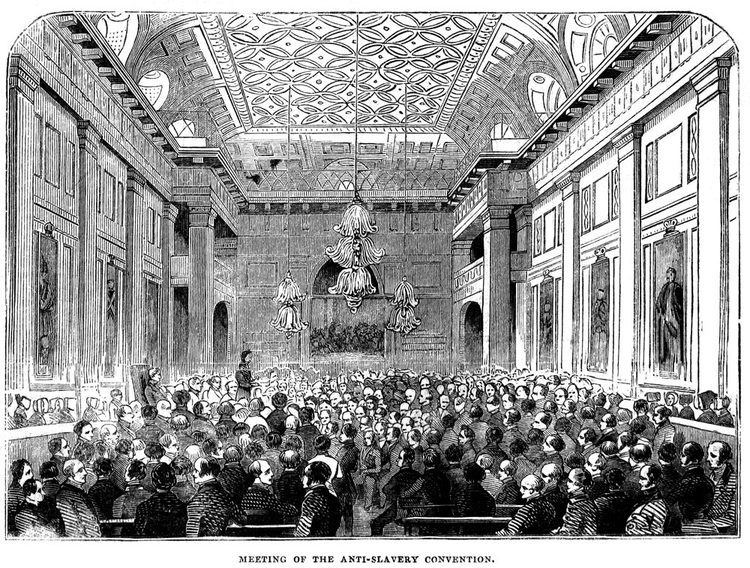Dates 12 Jun 1840 – 23 Jun 1840 | ||
 | ||
The World Anti-Slavery Convention met for the first time at Exeter Hall in London, on 12–23 June 1840. It was organised by the British and Foreign Anti-Slavery Society, largely on the initiative of the English Quaker Joseph Sturge. The exclusion of women from the convention had important ramifications for the women's suffrage movement in the United States.
Contents

Background

The Society for the Abolition of the Slave Trade was principally a Quaker society founded in the eighteenth century by Thomas Clarkson. The slave trade had been abolished throughout the British Empire in 1807. In August 1833 the British government passed the Slavery Abolition Act, advocated by William Wilberforce, which abolished slavery in the British Empire from August 1834, when some 800,000 people in the British empire became free.

Given the perceived need for a society to campaign for anti-slavery worldwide, the British and Foreign Anti-Slavery Society (BFASS) was accordingly founded in 1839. One of its first significant deeds was to organize the World Anti-Slavery Convention in 1840: "Our expectations, we confess, were high, and the reality did not disappoint them." The preparations for this event had begun in 1839, when the Society circulated an advertisement inviting delegates to participate in the convention. Over 200 of the official delegates were British. The next largest group was the Americans, with around 50 delegates. Only small numbers of delegates from other nations attended.
The circular message, distributed in 1839 provoked a controversial response from American opponents of slavery. The Garrisonian faction supported the participation of women in the anti-slavery movement. They were opposed by the supporters of Lewis Tappan. When the latter group sent a message to the BFASS opposing the inclusion of women, a second circular was issued in February 1840 which explicitly stated that the meeting was limited to "gentlemen".
Despite an earlier statement that women would not be admitted, seven female abolitionists, including Lucretia Mott and Lady Byron, appeared at the World Anti-Slavery Convention in London. Wendell Phillips proposed that female delegates should be admitted, and much of the first day of the convention was devoted to discussing whether they should be allowed to participate.
A painting of the proceedings was commissioned that today is in the National Portrait Gallery. This very large and detailed work shows Alexander as Treasurer of the new Society. The painting portrays the 1840 meeting and was completed the next year. The new society's mission was "The universal extinction of slavery and the slave trade and the protection of the rights and interests of the enfranchised population in the British possessions and of all persons captured as slaves."
Proceedings (incomplete)
The convention's organising committee had asked the Reverend Benjamin Godwin to prepare a paper on the ethics of slavery. The convention unanimously accepted his paper which condemned not just slavery but also the world's religious leaders and every community who had failed to condemn the practise. The convention resolved to write to every religious leader to share this view. The convention called on every religious communities to eject any supporters of slavery from their midst.
George William Alexander reported on his visits in 1839, with James Whitehorn, to Sweden and the Netherlands to discuss the conditions of slaves in the Dutch colonies and in Suriname. In Suriname, he reported, there were over 100,000 slaves with an annual attrition rate of twenty per cent. The convention prepared open letters of protest to the respective sovereigns.
Joseph Pease spoke and accused the British government of being complicit in the continuing existence of slavery in India.
Legacy
Ten years later the National Women's Rights Convention was held in America as a result of women, namely Lucretia Mott and Elizabeth Cady Stanton, who had met here and been denied full access to the proceedings.
One hundred years later the Women's Centennial Congress was held in America to celebrate the progress that women had made since they were prevented from speaking at this conference.
